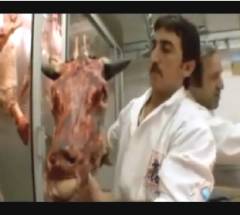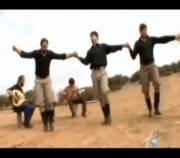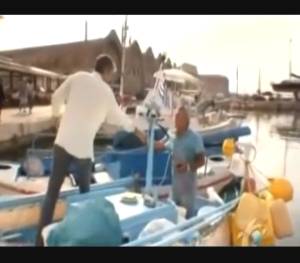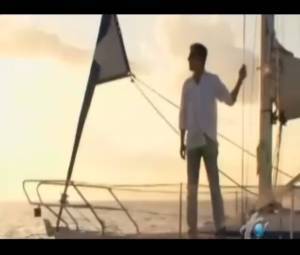Myths have it that Greece has the world's healthiest diet. From Crete to Ithaca, Anthony Bourdain heads off on a culinary odyssey to find out if that reputation is deserved. Unhappy past experiences left Anthony somewhat jaded and adverse to Greek food, but he finally succumbs to the idea of visiting the Greek isles declaring his refusal to eat moussaka.
Often surrounded by music, dancing men, various firearms, and distilled local spirits, Anthony discovers how a history of invasion, occupation, and deprivation have shaped the Greek cuisine over the centuries.
Introduction:
The Greek Islands are a collection of over 6,000 islands and islets that belong to Greece. Only 227 of the islands are inhabited, and only 78 of those have more than 100 inhabitants.
The largest Greek island by area is Crete, located at the southern edge of the Aegean Sea. The second largest island is Euboea, which is separated from the mainland by the 60m-wide Euripus Strait, and is administered as part of the central Greece periphery. After the third and fourth largest Greek Islands, Lesbos and Rhodes, the rest of the islands are two-thirds of the area of Rhodes, or smaller.
Crete
With a population of more than 600,000 people, Crete is the largest and most populous of the Greek islands and the fifth largest island in the Mediterranean Sea.
During the Neolithic and Bronze Age period, Crete was the centre of the Minoan civilization (c. 2700–1420 BC), the first civilization in Europe and the first European country with a palace (at Knossos). Under the Minoans, Crete had a highly developed, literate civilization. Since then, it has been ruled by various ancient Greek entities, the Roman Empire, the Byzantine Empire, the Emirate of Crete, the Republic of Venice and the Ottoman Empire. After a brief period of autonomy (1897–1913) under a provisional Cretan government, it joined the Kingdom of Greece. It was occupied by Nazi Germany during the Second World War.
Today, Crete forms a significant part of the economy and cultural heritage of Greece while retaining its own local cultural traits (such as its own dialect, poetry, and music). Cretans are fiercely proud of their island and customs, and men often don elements of their traditional dress in everyday life: knee-high black riding boots, black shirts and black headdress consisting of a fishnet-weave kerchief worn wrapped around the head or draped on the shoulders.
The economy of Crete is predominantly based on agriculture and is one of the few Greek islands that can support itself independently without a tourism industry. However, Crete is one of the most popular holiday destinations in Greece. Fifteen percent of all arrivals in Greece come through the city of Heraklion (port and airport). Heraklion is the largest city and capital of Crete with 130,914 inhabitants.
Overall, more than two million tourists visited Crete last year. Today, the island's tourism infrastructure caters to all tastes, including a very wide range of accommodation. Popular tourist attractions include the archaeological sites of the Minoan civilization, the Venetian old city and port of Chaniá, the Venetian castle at Rethymno, and the gorge of Samaria.
Chaniá is the second largest city of Crete, with a population of is 55,838; its greater urban area has a population of 81,985. Chaniá lies at the west end of Crete, right between the two other islands of the greek peninsula. Fortunately, Chaniá and Crete in general escaped the disastrous consequences of the Greek Civil War of the post-World War II years.
Zakynthos
Zakynthos, also known as Zante, is the third largest of the Ionian Islands, a group of islands in Greece traditionally called the Heptanese ("the Seven Islands") off the west coast of Greece, in the Ionian Sea. With a population of only 41,472, Zakynthos is one of the regions with highest population growth in Greece. The city of Zakynthos is the capital of the island of Zakynthos.
The famous ancient Greek poet and writer, Homer, first mentioned the island in his masterpieces, the Iliad and the Odyssey.
Zakynthos, along with the rest of the Ionian islands, spent six centuries as a subject of the Republic of Venice (1194-1797). Venetian rule protected the island from Ottoman domination but in its place it put a feudal oligarchy. The cultural influence of Venice (and of Venetian on local dialect) was considerable. The wealthy made a habit of sending their sons to Itlay to be educated. A good example is Dionysios Solomos, a native of Zakynthos and Greece's national poet. However, both the Greek language and Orthodox faith survived intact.
During the Napoleonic wars the islands were occupied at different times by France (which induced the peasants to revolt), Russia, Turkey and finally Britain, which held on to them until 1864, when they were ceded to Greece. During the Nazi occupation of Greece, Mayor Karrer and Bishop Chrysostomos refused Nazi orders to turn in a list of the members of the town's Jewish community for deportation to the death camps. Instead they secreted the town's 275 Jews in rural villages. All survived the war. But as punishment the Nazis took all the children to work at camps but not to be killed. After the war, all of the Jews of Zakynthos moved either to Israel or to Athens.
This "paradise on earth" suffered a series of four severe earthquakes in August 1953, resulting in the total destruction of the island's infrastructure, including most of its state archives. The rebuilding of the island was subject to a very rigid anti-seismic code, and has thus withstood several moderate and powerful earthquakes at a small amount of damage. Today, tourism continues to thrive and Zakynthos is currently one of the most popular tourist destinations in Greece.
Episode Recap:
Anthony Bourdain begins his culinary odyssey in the bustling city of Heraklion, Crete. He meets up with his guide Byron Ayanoglu, a local food writer, to help him quickly get over his prejudices and biases toward Greek food.
 Iraklia Market: Byron guides Anthony around the Iraklia Market and shows Anthony firsthand the myriad of fish Greece has to offer, yet few Cretan can actually afford to eat. Instead, the staple of the Cretan diet, and the secret to their longevity, is the island's abundance of wild assorted greens. As an afterthought, Byron adds that the olive oil, lamb and raki may help, too. After a stop by a market butcher, Anthony's eager to dive into the cuisine.
Iraklia Market: Byron guides Anthony around the Iraklia Market and shows Anthony firsthand the myriad of fish Greece has to offer, yet few Cretan can actually afford to eat. Instead, the staple of the Cretan diet, and the secret to their longevity, is the island's abundance of wild assorted greens. As an afterthought, Byron adds that the olive oil, lamb and raki may help, too. After a stop by a market butcher, Anthony's eager to dive into the cuisine.
Pantheon Restaurant: Byron takes Anthony for lunch at the Pantheon Restaurant. Anthony is impressed with the tripe soup, the fish, lamb sweetbreads, and stewed wild goat, as well as the chickpeas sauteed in lemons and olive oil, the ubiquitous greens, and other traditional dishes that date back to the Minoans and the Ottomans.
Raki Distillery: Anthony and Bryon head to the countryside to see how is raki made. Raki is Greece's version of "legal moonshine." Only the owner of wine vineyards are allowed to distill and make raki. After a few glasses of raki and some pieces of lamb, Anthony decides he's drunk enough for some Greek music, and the party begins with lots of other Cretan dishes, and of course, more raki. Anthony decides his first day in Greece is a success.
 Anogia: Anthony visits the mountain town of Anogia (or Anoyia) to attend a lunch some local villagers are hosting in his honor. Amidst much drinking of yet more raki and the serenade by local musicians playing traditional folk music, Anthony watches as the men shave, slaughter, skin and sizzle a lamb on large skewers. The meal concludes with a special dish—lamb intestines stuffed with lamb spleen. After the meal, more drinking, dancing and shooting of firearms.
Anogia: Anthony visits the mountain town of Anogia (or Anoyia) to attend a lunch some local villagers are hosting in his honor. Amidst much drinking of yet more raki and the serenade by local musicians playing traditional folk music, Anthony watches as the men shave, slaughter, skin and sizzle a lamb on large skewers. The meal concludes with a special dish—lamb intestines stuffed with lamb spleen. After the meal, more drinking, dancing and shooting of firearms.
Anogia has a history that is powerful and tragic—burned by the Turks, then by the Germans who during World War II, as reprisal for kidnapping a German general, rounded up and shot all the men they could find in the village.
Green Harvesting: Anthony witnesses some locals harvesting the wide assortment of wild greens that grow along the mountainside and right outside their backyards.
The Greeks learned how to live off wild greens during World War 2 when the German's stripped Greece of its food to feed German soldiers throughout Europe. Those that didn't starve to death, learned to survive off the more than 1,000 different types of wild greens that grow on the hillsides. Since, their famed greens have been accredited with giving Cretans their long life.
Home-cooked Greens: Anthony marvels at how creatively former chef Manolus prepares their meal. It's an all-star showcase of local ingredients made with what's available in everybody's backyard—freshly harvested snails, greens, stewed onions and tomatoes, and finally a dip called staka, made from the butterfat of goat's milk slowly warmed and thickened with flour. Yet another stunningly good Greek meal.
 Neoria Seaside Taverna: Anthony meets up with Adante, a local fisherman who specializes in catching Anthony's favorte seafood: sea urchin. They're joined by Byron at Neoria Seaside Taverna to feast on Adante's recent fresh catch. They start with grilled octopus, fried cuttlefish, sheep-milk cheese on tomato puree and barley rusk, and Anthony's beloved sea urchin roe swimming in local olive oil, slathered on bread, all washed down with yet again, raki. Then they move on to shrimp stewed with feta cheese, grilled fish, fresh squid with lemon, grape leaves stuffed with rice, dill and onion, and, finally, the inevitable greens, followed by more raki.
Neoria Seaside Taverna: Anthony meets up with Adante, a local fisherman who specializes in catching Anthony's favorte seafood: sea urchin. They're joined by Byron at Neoria Seaside Taverna to feast on Adante's recent fresh catch. They start with grilled octopus, fried cuttlefish, sheep-milk cheese on tomato puree and barley rusk, and Anthony's beloved sea urchin roe swimming in local olive oil, slathered on bread, all washed down with yet again, raki. Then they move on to shrimp stewed with feta cheese, grilled fish, fresh squid with lemon, grape leaves stuffed with rice, dill and onion, and, finally, the inevitable greens, followed by more raki.
Bougatsa Hanion: Anthony joins Byron for a traditional Greek breakfast. First they visit Bougatsa Hanion, a small bakery shop, for a Hanian delicacy: bougatsa. Bougatsa is a Greek breakfast pastry consisting of custard, cheese, or minced meat filling between layers of phyllo (or filo). Here the same baker has handmade the gossamer-thin, filament-thin phyllo from scratch for 20 years. Anthony watches in fascination as the pastry is being created. When the pastry's thin enough and just right, it's stuffed with a rich cheese called mizithra, a Greek-style saltier version of ricotta, then it's folded, and finally placed into the oven. When the batch comes out of the oven, Anthony follows it around the corner to the cafe when its served fresh and hot.
 Mediterranean Cruise: Anthony's culinary odyssey takes him to the beautiful green island of Zakynthos. As they sail across the Mediterranean sea, Anthony and Byron discuss Greek history, myths and philosophy, and what it means to be Greek.
Mediterranean Cruise: Anthony's culinary odyssey takes him to the beautiful green island of Zakynthos. As they sail across the Mediterranean sea, Anthony and Byron discuss Greek history, myths and philosophy, and what it means to be Greek.
Quail Hunt: Anthony joins guide Popos and his hunting dog Ceasar on a quail hunt in the Zakynthos countryside. Unfortunately, Anthony literally blasts a quail out of the sky, rendering it inedible.
Alitzarini Restaurant: Anthony and Popos visit the medieval settlement of Koiliomenos where they dine at Alitzarini Restaurant. The restaurant specialize in the traditional dishes of Zakynthos like lamb spleen stuffed with pungent local cheese, flavored with cinnamon and clove; lamb guts wrapped in chitlins and stewed in a spicy tomato sauce; a Zakynthos favorite—rabbit braised in onions, spices and wine; and quail grilled and then roasted while basted with lemon. The meal's accompanied by a bottle of Greek wine.
Picnic on Shipwreck Beach: Anthony concludes his Greek culinary odyssey with a trip to Shipwreck Beacha, small beach cove only accessible by boat and a favorite spot for family picnics. Anthony and Byron join a family for one such picnic, complete with musicians and dancing. They prepare grilled octopus and a specialty found almost anywhere people of modest means live by the sea—a fisherman's stew made of cheap, bony, but readily available fish, tomatoes and onion.
Anthony finally admits to Byron that he has changed his initial misconception about Greek food and that he's happy he did indeed finally came to Greece.
Episodes:
 |
ARGENTINA: From the Tango to paragliding to cattle rustling to trekking along icy glaciers, Anthony experiences it all. |
 |
AUSTRALIA: Melbourne has been described as San Francisco without the fog. Anthony is off to discover what makes it so special. |
 |
BERLIN: Anthony finds himself in Berlin, a city that is for him both good and evil, Eastern and Western, repulsive and appealing. |
 |
BRAZIL: Some say São Paulo feels like LA threw up on NYC. But Anthony's back for the great food and its welcoming people. |
 |
CALCUTTA & BOMBAY: Anthony revisits his love for India's vibrant culture, cuisine & communities with a trip to Kolkata & Mumbai. |
 |
COLOMBIA: A bright and beautiful country that has gone from drug capital to food capital. Anthony explores its unique cuisine. |
 |
EGYPT: Anthony skips the long lines and tour buses, and visits with Egyptian locals to get a taste for what it means to be Egyptian. |
 |
GHANA: Anthony heads to Ghana, West Africa, a land of old forts and slave castles, and a culture filled with great food and music. |
 |
HONG KONG: A wonder-land of colors, lights and speed, a perfect marriage of modern and traditional, and home to great Asian cuisine. |
 |
IRELAND: Ireland's steeped in history and traditions, both oral & written. Anthony dispels the myths that it has the worst food on the planet. |
 |
JAMAICA: Jamaica is a vibrant, colorful land full of resorts and reggae music. Anthony is there to uncover the lesser-known Jamaica. |
 |
KOREA: Anthony gives in to his employee's pressure to visit Korea and, next thing you know, they're in Seoul and the adventure begins. |
 |
MEXICO: Carlos, a head chef in NYC and good friend, gives Anthony a culinary tour of his hometown Puebla and nearby Mexico City. |
 |
OSAKA (Japan): Anthony learns all about kuidaore, which means to bankrupt oneself with extravagance in food and drink! |
 |
PARIS: In this very first episode of the series, Anthony heads to the "City of Light" to show, at least the Americans, why the French don't suck. |
 |
PERU: Anthony is on a mission to obtain personal enlightenment in a land of ancient culture, rich cuisine, and vibrant people. |
 |
QUEBEC (Canada): Anthony is off to Québec to indulge in one of his most hedonistic pleasures–foie gras (fatty duck liver). |
 |
RAJASTHAN (India): From gorgeous sights to enticing smells, Anthony explores the magical and delicious offerings of Rajasthan. |
 |
ROME: Anthony adopts the mindset of the Roman people–living a simple life and eating fresh, seasonal ingredients. |
 |
RUSSIA: Anthony explores Russia, where the food is hearty. Along the way he meets a former Cold War spy and Miss Russia. |
 |
SHANGHAI (China): Anthony is back in China. From Shanghai to Tibet, he searches for the mythical Shangri-La. |
 |
SICILY: Anthony starts his gastronomic tour through Sicily in style by sharing a spleen sandwich with Sicily's president. |
 |
SINGAPORE: Singapore is serious about food and offers up a cuisine like no other. Anthony dives in head-first. |
 |
SPAIN: According to Anthony, outside of Asia, Spain is the single greatest place for culinary achievement in the world. |
 |
TOKYO: Anthony is off to Tokyo in search of the relationship between a perfect piece of sushi and a perfect knife blade. |
 |
TUSCANY: Anthony travels to the beautiful Tuscan countryside to visit with friends and enjoy some homemade pasta that's out of this world. |
 |
URUGUAY: Anthony and his brother are on a mission to connect with their roots in Uruguay after learning that Bourdains once settled here. |
 |
VANCOUVER (Canada): Anthony visits Vancouver, home to a thriving film industry, gorgeous scenery, and an evolving food scene. |
Contact Us | Shop | Sitemap | Join Our Team | Investors | Advertise | Web Design Services
Community | Foodies' Choice | Meetup Groups | Chat | Blogs | Forums | Submit Your Site | Resources


